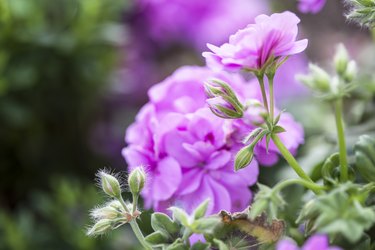
Ivy geraniums (Pelargonium peltatum) are herbaceous perennials native to Southern Africa. They are characterized by their thick lobed leaves, trailing stems and single or double blossoms that range from white to pink, pale purple or red. These warm-weather plants do best in U.S. Department of Agriculture plant hardiness zones 10 to 11, though they are also often grown as annuals in all zones. Home gardeners often cultivate ivy geraniums in outdoor window boxes or indoor hanging baskets, but these versatile plants also work well outdoors in flowerbeds or as ground cover. They are generally healthy and easy to care for.
Watering Requirements
Video of the Day
Ivy geraniums grow best in moderately moist soil. They cannot tolerate wet feet. Plant your outdoor ivy geraniums in well-drained soil, and make sure containers have drain holes so excess water can escape. Ivy geraniums should be thoroughly watered, but the top 2 inches of soil need to dry out before you water them again. Apply the water directly to the soil, and avoid wetting the leaves or blossoms.
Video of the Day
Fertilizing Plants
Avoid over-fertilizing geraniums, as this can limit blooms, warns the University of Minnesota Extension. Add 2 teaspoons of a water-soluble fertilizer such as 20-20-20 to a gallon of water and feed outdoor geraniums approximately every three weeks. Adding a teaspoon of Epsom salts to a gallon of fertilizer will supplement the ivy geranium's magnesium needs.
Pruning Ivy Geraniums
Deadhead spent blossoms from your ivy geranium plants. You can also pinch back long stems to promote bushiness. Pruning tools can spread disease from one plant to another, so disinfect your shears before and after use by soaking them for at least five minutes in an equal mixture of rubbing alcohol and water, or one part household bleach to three parts water.
Climate and Temperature
Ivy geraniums grow best in temperatures between 65 and 80 degrees Fahrenheit. In hot climates, plant outdoor ivy geraniums in a location where they will receive mid-day shade. Move outdoor container plants into a shadier location if temperatures exceed 85 degrees Fahrenheit. They are sensitive to cold, so bring in container plants before the temperature drops below 45 degrees Fahrenheit. Overwinter your plants indoors if you live in a cold climate -- or simply treat them as annuals and replant each spring.
Health Problems
Edema is a common problem in ivy gernaiums. Yellow spots form between the leaf veins, and clear watery blisters form on the underside of the leaves below the yellow spots. The blisters grow and turn brown and develop a cork-like texture. The leaves turn yellow and fall from the plant. This disorder usually occurs during periods of cool, humid, overcast weather, when the plant absorbs more water than it loses. Ensure you are not over-watering, the soil is well-draining and there is enough space between plants for proper air circulation.
Ivy geraniums planted in poorly-drained soil may also develop root or stem rot. Water your plants in the morning so that the excess water has a chance to drain and does not stand overnight, and avoid wetting the foliage.
Pests
Insects such as aphids, mealybugs and whiteflies extract sap from ivy geranium plants, and excrete a sugary liquid called honeydew. An unsightly black fungus called sooty mold can form on the honeydew.
Remove aphids by mixing a tablespoon of liquid soap into a gallon of water and spraying the plant. Dip a cotton ball in rubbing alcohol to wipe mealybugs off plants.
Twospotted spider mites drain plant juices from the leaves, creating yellow spots and leaving unsightly webbing on the foliage. Spraying ivy geraniums with a hard spray of water will dislodge mites and their eggs.
You can also use a horticultural oil such as neem oil to control aphid, mealybug, whitefly and spider mite populations. Spray plants thoroughly, making sure to apply the oil to the undersides of leaves.
- Missouri Botanical Garden: Pelargonium peltatum
- University of Minnesota Extension: Outdoor-Indoor Geranium Culture
- Cornell University: Cornell Gardening Resources – Soil Basics
- Flower Gardening Made Easy: Growing Geraniums
- Iowa State University Extension and Outreach: Horticulture and Home Pest News – Ivy Geraniums
- University of Florida IFAS Extension: Disinfecting Pruning Tools
- Penn State College of Agricultural Sciences Extension: Edema of Geranium
- Fine Gardening: Geranium Pelargonium “Roger’s Delight”
- University of Minnesota Extension: Managing Whiteflies on Indoor and Outdoor Plants
- My Green Space: Gardening – Keeping Pests in Check with Horticultural Oils
- University of Florida IFAS Extension: Sooty Mold on Landscape Plants
- University of California Statewide Integrated Pest Management Program: Spider Mites